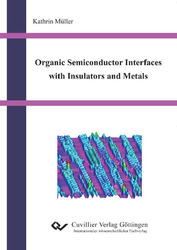| Fachbereiche | |
|---|---|
| Buchreihen (96) |
1378
|
| Nachhaltigkeit |
3
|
| Gesundheitswesen |
1
|
| Geisteswissenschaften |
2365
|
| Naturwissenschaften |
5406
|
| Mathematik | 229 |
| Informatik | 319 |
| Physik | 980 |
| Chemie | 1363 |
| Geowissenschaften | 131 |
| Humanmedizin | 243 |
| Zahn-, Mund- und Kieferheilkunde | 10 |
| Veterinärmedizin | 108 |
| Pharmazie | 147 |
| Biologie | 835 |
| Biochemie, Molekularbiologie, Gentechnologie | 121 |
| Biophysik | 25 |
| Ernährungs- und Haushaltswissenschaften | 45 |
| Land- und Agrarwissenschaften | 1004 |
| Forstwissenschaften | 201 |
| Gartenbauwissenschaft | 20 |
| Umweltforschung, Ökologie und Landespflege | 148 |
| Ingenieurwissenschaften |
1793
|
| Allgemein |
98
|
|
Leitlinien Unfallchirurgie
5. Auflage bestellen |
|
Erweiterte Suche
Organic Semiconductor Interfaces with Insulators and Metals
Kathrin Müller (Autor)Vorschau
Inhaltsverzeichnis, Datei (43 KB)
Leseprobe, Datei (160 KB)
The electronic interactions of self-assembled organic semiconductors with metals, metal-oxides and ultrathin insulator surfaces have been investigated by complementary analysis techniques comprising scanning tunnelling microscopy and spectroscopy, low energy electron diffraction, x-ray photoelectron spectroscopy and ultraviolet photoelectron spectroscopy.
Two model systems have been chosen and investigated: The first model system comprises the electronic interactions and the self-assembly of pentacene molecules on the Cu(110) as well as on the oxidized Cu(110) surface. In a second model system the interface of octa-ethyl porphyrins with ultrathin insulator films and metals has been investigated. The adsorption of molecules on insulator surfaces is especially interesting due to the strong reduction of the electronic and chemical interactions between the molecules and the substrate.
The investigation of pentacene on the Cu(110) surface revealed a multi-phase behaviour, which is characterized by molecular bending, molecular mobility, different relative orientation of the molecules and different packing densities. Furthermore, the influence of the adsorbate layer on the Shockley surface state of the Cu(110) has been investigated. A complex interplay of different phenomena, like Pauli repulsion, charge transfer, mixing and
hybridization of electronic states as well as the polarization of the organic adsorbate in the surface dipolar field, lead to a shift of the surface state to higher binding energies.
Additionally, the occupation of the surface state is increased for the adsorption of one monolayer of pentacene. This particular behaviour has not been reported for any other molecular/metal system so far. The adsorption of pentacene on the oxidized Cu(110) surface reveals that the electronic interactions and the surface corrugation determine the self-assembly of the molecular ad-layer.
The second project in this thesis comprises the electronic interactions of porphyrin molecules, another representative of molecular semiconductors, with ultrathin insulator layers. The main question here was how the electronic interactions between the molecules and the substrate change with increasing insulator thickness and whether it is possible to electronically decouple the molecules from the substrate for one or two monolayer thin insulator films. A detailed growth study of NaCl on different metal surfaces led to samples, which were homogenously covered with 1 ML of NaCl and thus could be investigated by non-local analysis techniques like UPS and XPS. Low temperature STS and angle-resolved UPS data showed that the CuOEP molecules strongly interact with the Cu(111) and Ag(111) substrate leading to unoccupied electronic states in the band gap of the molecule on Ag(111) and to quenching of the Shockley surfaces state for the adsorption of CuOEP on Cu(111).
Further UPS and XPS measurements revealed a strong influence of the chemical environment on the binding energies, as identified by shifted peaks for CuOEP on NaCl compared to CuOEP on the metal surfaces. These peak shifts have been related to strong screening of the photoelectron hole.
| ISBN-13 (Printausgabe) | 3869551186 |
| ISBN-13 (Printausgabe) | 9783869551180 |
| ISBN-13 (E-Book) | 9783736931183 |
| Sprache | Englisch |
| Seitenanzahl | 110 |
| Auflage | 1 Aufl. |
| Band | 0 |
| Erscheinungsort | Göttingen |
| Promotionsort | Universität Zürich |
| Erscheinungsdatum | 12.10.2009 |
| Allgemeine Einordnung | Dissertation |
| Fachbereiche |
Physik
|








